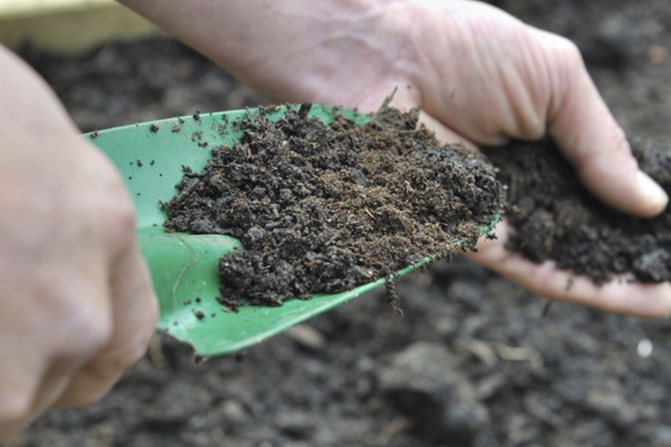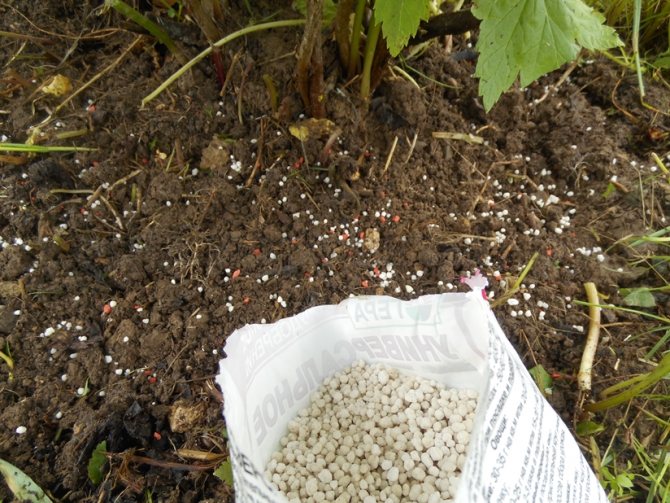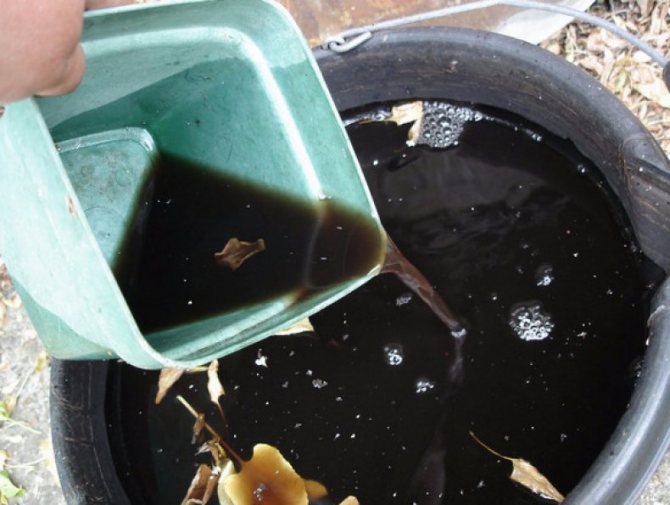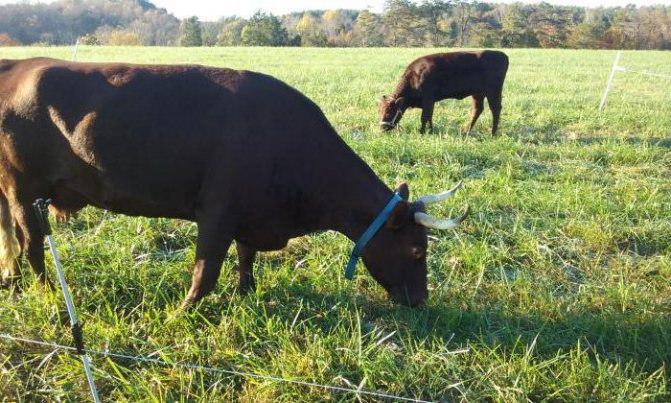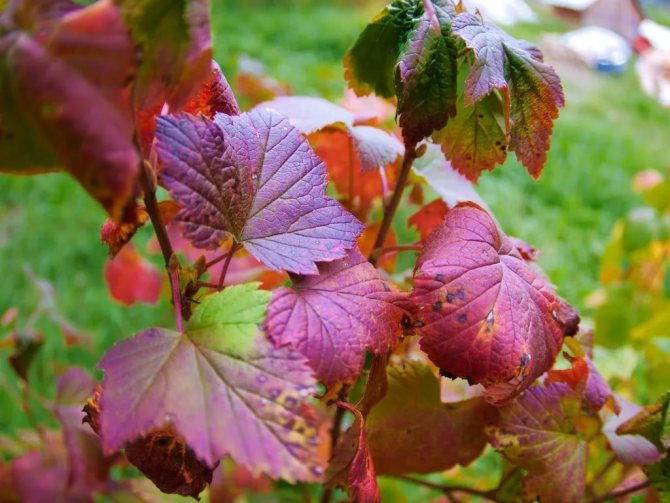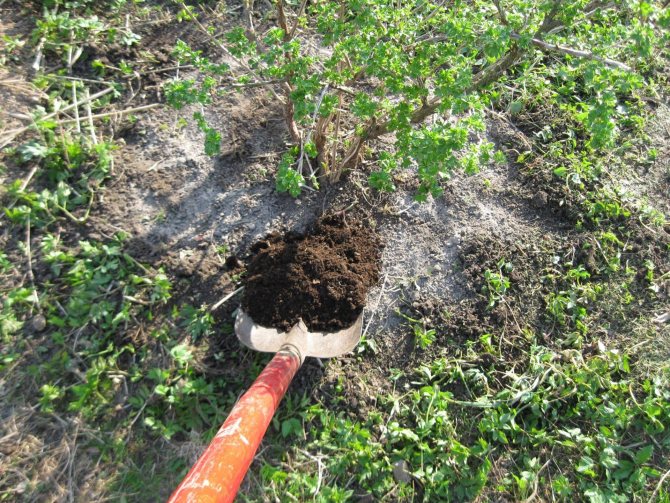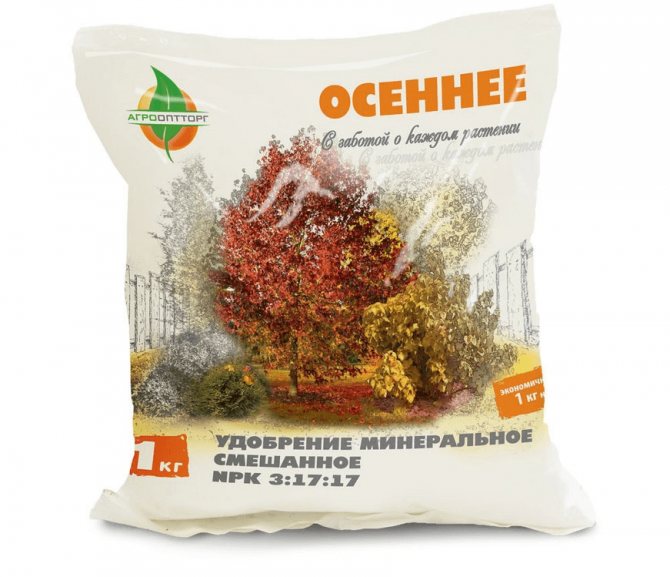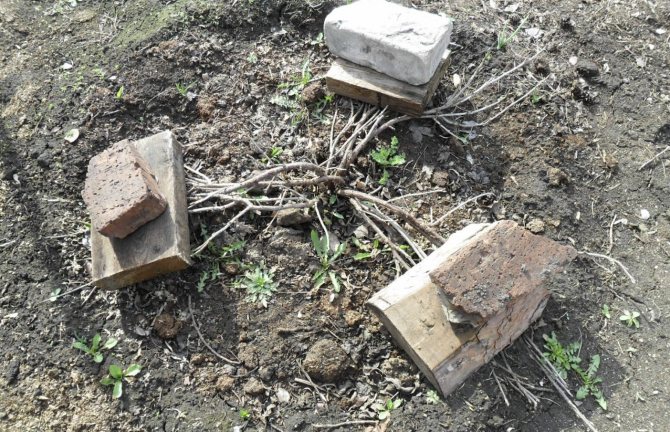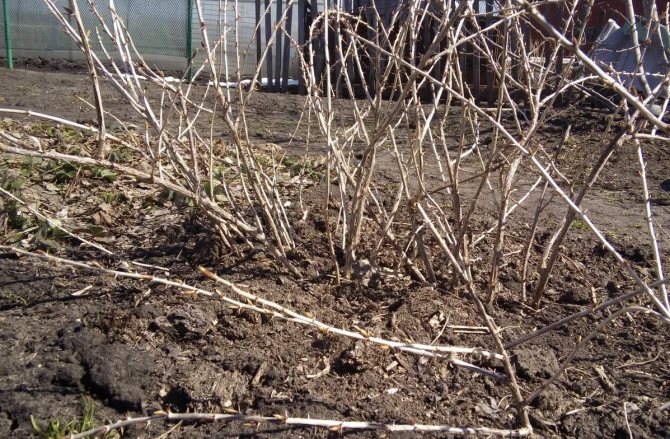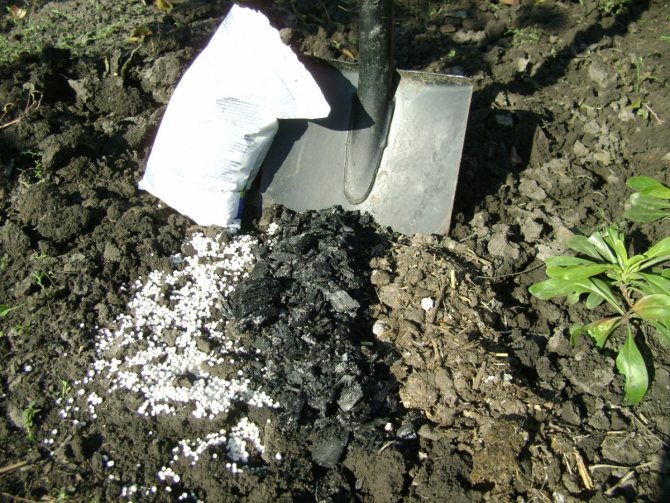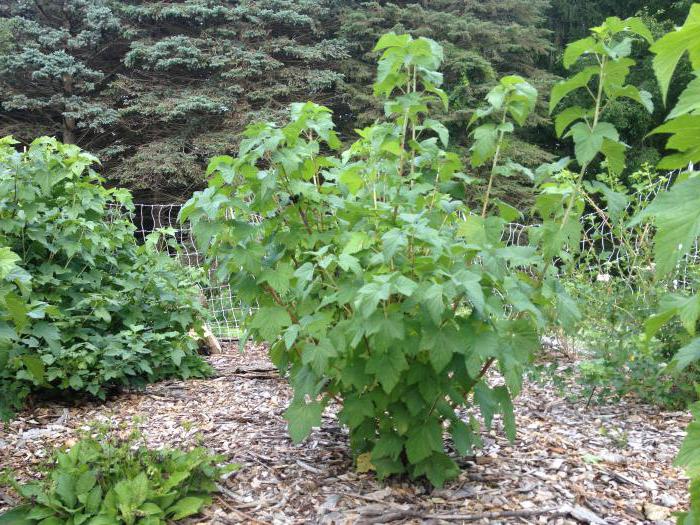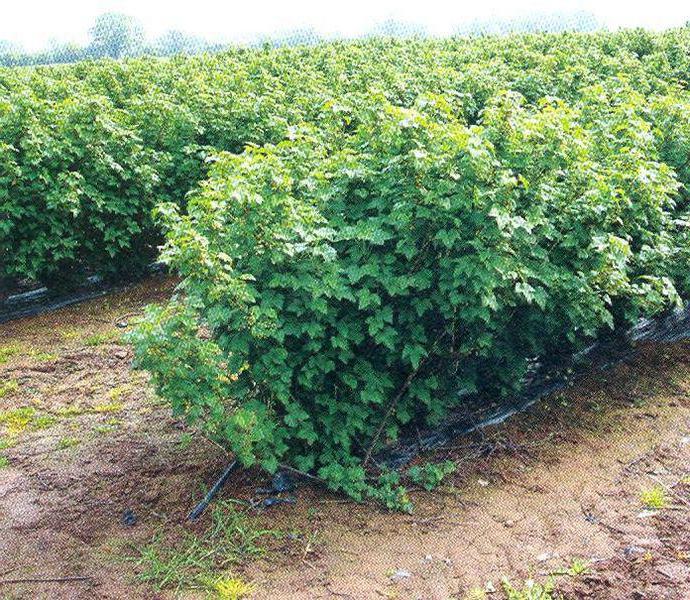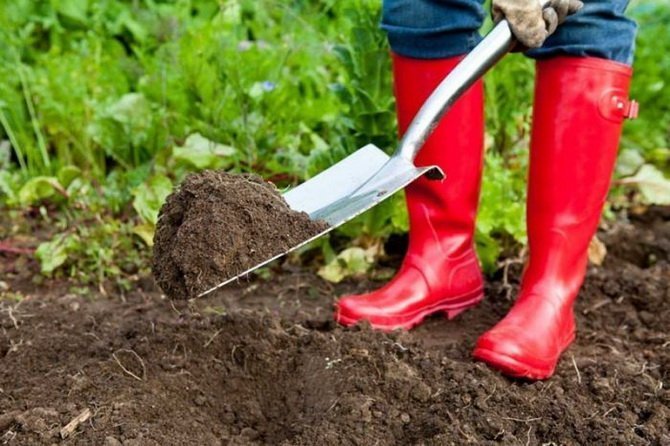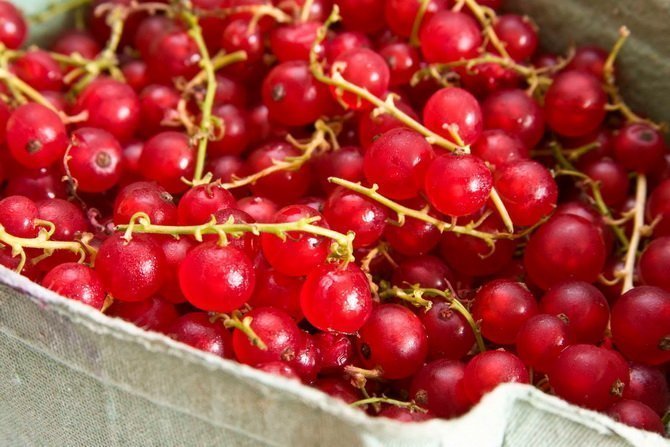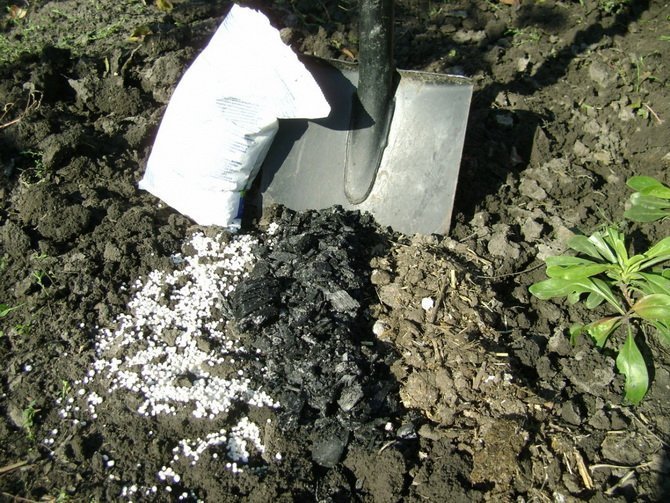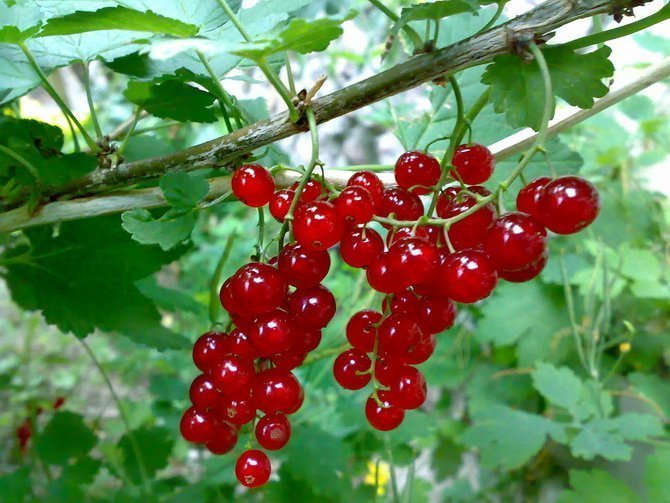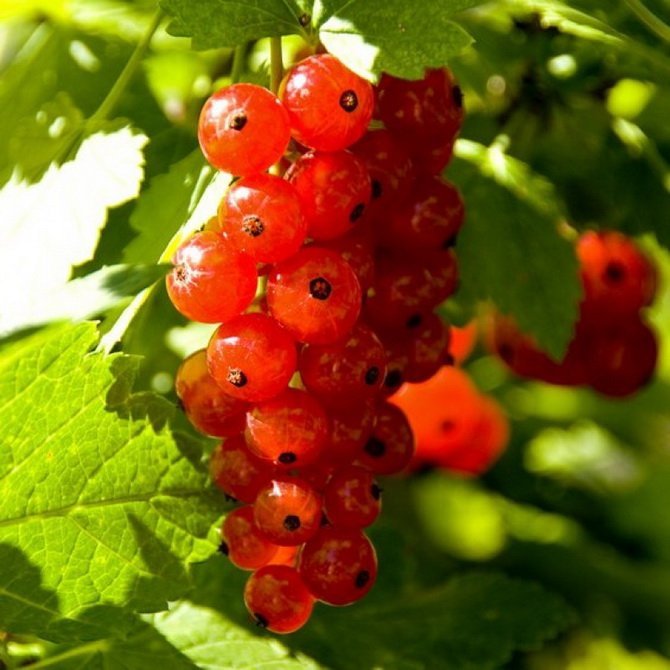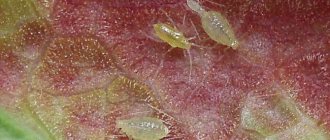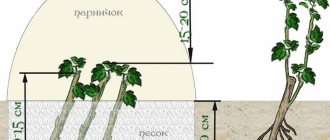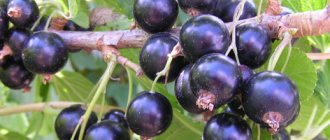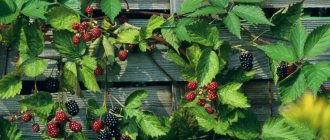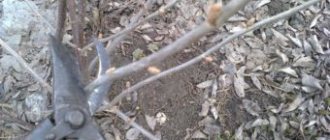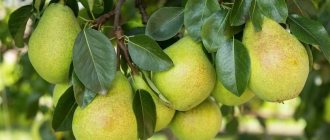Top dressing of currants in the fall is a guarantee of a good harvest for the next year. Organic and inorganic fertilizers will provide nourishment to the roots immediately after the snow melts, buds will be laid faster. In addition, strong bushes will better resist diseases and insect pests, which are also activated in the spring.
- 2 How often to fertilize in the fall
- 3 Correct feeding of currants: step by step instructions
3.1 Video: a convenient way to fertilize
- 3.2 Video: comprehensive care for black currants in autumn
Processing of near-trunk circles
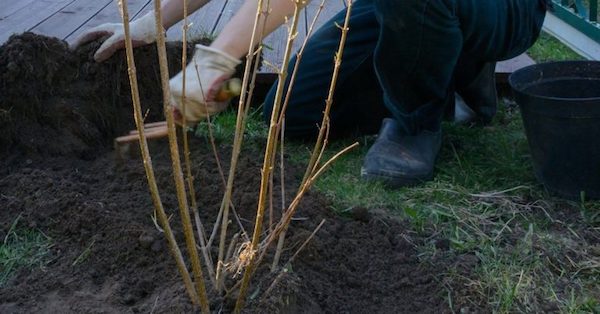
This care for currants in the fall can be done in two ways. Each has positive and negative sides.
- Digging supporters believe that digging up the earth (with the circulation of layers) retains moisture and contributes to the death of pests that have survived in the soil. Moreover, the aisles are dug deeper. Opponents believe that when digging the ground, there is a high probability of damaging the roots of the bushes, which are located shallowly.
- When mulching the soil in the trunk circle, soil moisture is preserved. The ground remains loose.
Disease prevention
In autumn, work is carried out to prevent diseases and to destroy parasitic insects. A kidney mite is very dangerous for currants, the females of which lay larvae in the kidneys. While developing, they infect the kidney, and when it opens, they crawl to a new one.
Therefore, autumn preventive treatment of bushes is important. It can be carried out with the following drugs and compositions:
- Bordeaux liquid solution 1%;
- Fundazole;
- Aktara;
- Soon;
- Fitosporin, etc.
It is important to choose the right processing time for the plant. If you are late, there will be little sense from spraying the branches, the main part of the work is postponed to the spring.


Sprinkling of currant bushes with fungicide in early spring
You can not spray the bushes if the air temperature drops below +20 degrees.
How to fertilize the soil
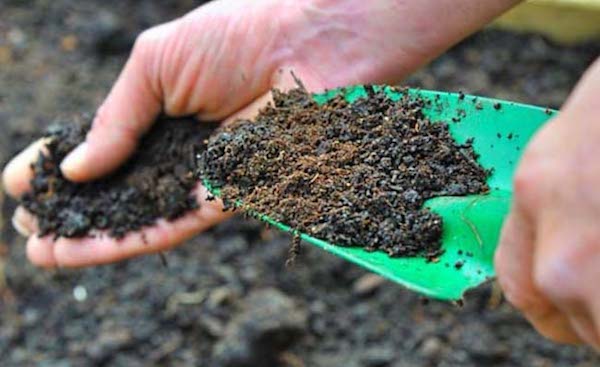

In autumn, it is categorically impossible to use nitrogen-containing mineral mixtures - the growth of new shoots will seriously reduce the frost resistance of the bushes. If the plants are severely depleted, then mineral supplements are indispensable.
In the fall, any varieties of currants need phosphorus and potassium dressings. You can apply a solution of superphosphate with potassium sulfate (a tablespoon per bucket of water).
According to the advice of seasoned gardeners, it is recommended to use organic fertilizers (manure) as soon as the cold weather sets in and the shoots stop growing. The autumn use of organic matter is good because during the winter manure will acquire an easily digestible form and currants in the spring will better absorb useful elements and develop faster.
Do not neglect the autumn fertilization of the soil. Indeed, after the end of fruiting, the buds of the future harvest are laid on the bushes. And also nutritious dressings increase the immunity of currants.
Fertilization is combined with soil filling. For this, sawdust, peat are used. A great option is a mixture of sawdust (one bucket) and sifted wood ash (one glass). By the amount of bedding, they are guided by the thickness of the layer. It must be at least 10 cm.
Potassium sulfate.
Currants require mineral fertilizers.Since currants have an increased sensitivity to chlorine, it is best to add potassium sulfate.
In the fall, you can feed the plant with potassium chloride. During the winter, thanks to the rains and snow, chlorine will be washed out of the water, then the plant will be able to assimilate potassium.
Ash can also be applied as a mineral fertilizer; this is a simple folk remedy, but effective as a fertilizer. After all, ash contains more than 30 microelements necessary for plants.


Caring for black currants in the fall
This is a perennial shrub whose branches can grow up to two meters in height. Developing in one place, the bushes can bear fruit for 10-15 years. The root fibrous system grows in the half-meter topsoil at a distance of about 0.5-0.6 m from the center of the bush. This explains the sensitivity of black currants to drought.
After harvesting, it is important to water the bushes in a timely manner. For one plant, 2-3 buckets of water are enough. This is the key to successful wintering and good future fruiting.
At the end of the season, the focus is on sanitary pruning and formative pruning.
- Be sure to cut off the broken branches, which in the spring will no longer have shoots.
- It is also recommended to cut leaves that grow very low - literally spreading along the ground. Be sure to cut off the branches growing inside the crown.
A heavily thickened bush will not give a bountiful harvest. Experienced gardeners recommend leaving about 15 branches in the bush.


Scheme of cutting currants in the fall by years (according to the book by E. Sbitneva)
The last watering is carried out no later than mid-October. It is recommended to combine it with feeding the bushes. Since plants clearly respond to soil depletion. In autumn, complex mineral mixtures containing phosphorus and potassium are used (about 100 g of fertilizers are poured under each bush). After watering, it is recommended to mulch the soil.
The winter hardiness of the bushes is largely determined by the variety. Therefore, it is advisable to choose plants based on the climatic characteristics of the region.
Video: caring for currants in the fall
Don't make mistakes
You can love currants, try to care for it, but be wrong. For example, it can be a fatal mistake to apply cow dung in the fall, ostensibly to fertilize the plant. This is often done by novice gardeners, out of ignorance.
The problem is that the nitrogen contained in manure in large quantities stimulates the growth of green mass, and can also burn the roots. In the process of rotting, the temperature in it can rise up to 75 ° C, and for shoots this value can become fatal.
To prevent this from happening, manure is spread around the currants in a small layer in December. With this approach, decomposition will take place over the winter and in the spring the currants will receive a portion of the nutrients.
If water is retained on the site, manure can be omitted, it is useless in such conditions.
Other gardeners mistakes:
- Overdo it with the introduction of humus. If you put more than 10-15 kg per bush (depending on its size), the plant will not have time to prepare for winter, and in the spring it will begin to gain weight without forming flowers and ovaries.
- Breaking off branches, as well as working with a low-quality pruner - you need an even, gentle cut, otherwise the shoots will hurt more. Old, thick branches are generally better to cut with a garden saw, and cover the cut with garden pitch.
- Insulation of bushes with a film. Inside, along with an increase in temperature, moisture also rises. As a result, the plant deteriorates, and a fungus may develop in the spring.
Instead of polyethylene for insulation, you can use fallen needles, straw, foliage from the nearest forest. You cannot take foliage from the garden - many pests and bacteria larvae are hiding in it.
Each variety of currants has its own characteristics of care that must be taken into account.
How to care for red and white currants in the fall
Bushes of red or white currants are compact in shape and are capable of producing crops for about 25 years. If you provide proper care for white currants in the fall, then you will not have to worry about the fruiting of the bushes in the next season.
Plants are pruned in late autumn. In this case, the shape of the bush is immediately determined - sprawling or compact. Since the berries are mostly tied to mature branches, it is not recommended to prune them too much. It is possible to pick berries from the shoots of red currants for a longer time, so only sanitary pruning is carried out in the fall.
Currants grow well in open or slightly shaded areas. During the season, it is important to ensure that the plantings are not overgrown with weeds; in the fall, currants must be weeded regularly. Such care for red currants in the fall will contribute to a good laying of flower buds for the future harvest.
To ensure fertility in the next season, it is necessary to water the plants well as soon as the foliage falls. The main fertilizers are applied in early September.
The first days of autumn are an excellent period for plant breeding. It is advisable to prepare the pits in advance - so that the earth has time to settle. Saplings are planted and slightly cut off - a few buds are left on the branch.
Currants are watered before the onset of frost. At least three buckets of water are poured under each bush. Red currants are less demanding for watering than black currants. But with a lack of moisture, small berries will form.
When processing near-trunk circles, the soil is loosened shallowly so as not to touch the roots of the plants. Leaves from branches should not be torn off. When the leaves fall off by themselves, they are carefully picked and burned.
The bushes are hardy and you can cover the plants with snow to provide protection in winter.
Raw materials use.
Cut the fresh banana peel into small pieces. We dig dimples 5-10 cm deep near the red currants. It is very important that the raw materials do not touch the roots. Put the chopped peel into the dug out dimples. Then sprinkle with soil.
As a result, the banana peel will generate heat as it decomposes. After decomposition, the currants will absorb the necessary trace elements. Such autumn feeding will help the plant to winter well.
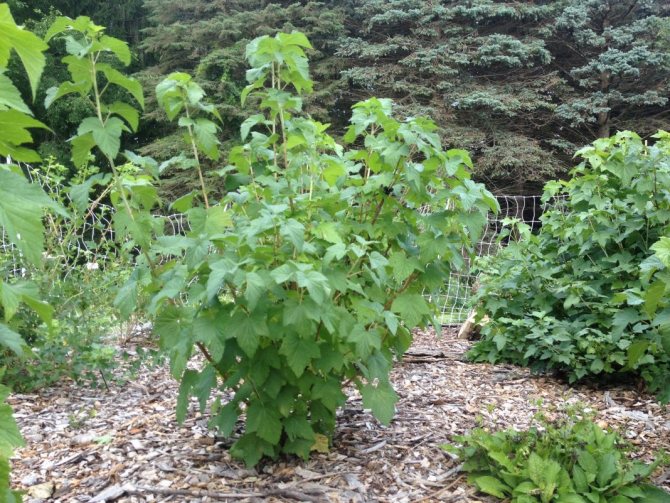

The use of raw materials as infusion.
Pour boiling water over the banana peel to disinfect. Then dry in the oven. Grind to a powder state, after which we prepare the infusion. To prepare an infusion in 1 liter of warm water, we dilute 3 tbsp. l. banana peel powder, 1 tsp. crushed eggshell and 20 g of magnesium sulfate.
Then we put the jar in a warm place for three hours. After that, filter and water the red currant. We apply top dressing in dry weather, after watering the plant with warm water.
Mulching.
Banana peels can be used as mulch for red currants. To do this, mix the banana peel with the soil from the garden in a bucket in a ratio of 1: 2. Mix well and pour with Baikal.
We mulch the soil with the resulting mixture. This mulch is perfect for the autumn care of the plant, because during the winter this mulch will turn into an excellent nutritious compost. And in the spring, the plant will receive the necessary nutrients.
Did you like the article?
- harvest
- Red currants
Autumn pest and disease control
Treatment from pests and diseases is an important step in caring for currants in the fall. After harvesting, you must carefully inspect the planting of currants. Most often, shrubs infect kidney mites and powdery mildew.
How to deal with a kidney mite
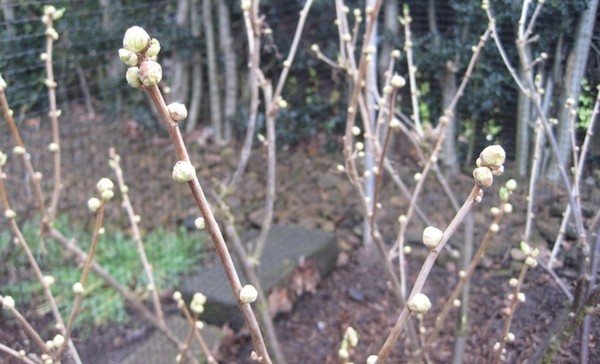

The pest affects the black currant bushes most of all. But white and red currants can also be affected.
- In the infected bushes, the buds do not bloom in the spring, but dry out. This causes a decrease in yield, the normal development of the bushes is disrupted, the plants die.
- The harm of the tick also lies in the fact that it carries mycoplasma disease (terry).
The tick hibernates and develops inside the kidneys. In affected plants, the buds become larger and more rounded. Infection and spread of pests occurs through the planting material, thanks to strong winds, birds, insects.
If there are 2-3 diseased kidneys on a branch, then they must be removed. If there are more such buds, then the entire branch is cut off.
Modern means - bioacaricides also effectively destroy kidney mites. The most popular drugs are:
- "Biokol",
- "Akarin",
- Fitoferm.
When applying them after harvesting, it should be borne in mind that the drugs act at elevated air temperatures (from 15 to 19˚C). In windy, cool autumn weather, they are useless.
After the end of the fruiting period, you can use pesticides with a strong effect. Acaricidal preparations:
- "Rotor-S",
- "Phosphamide"
- "Nitrafen".
As a preventive measure, it is recommended to regularly weed the plantings of currants. Fallen leaves and branches after sanitary pruning are immediately removed and burned.
How to protect yourself from powdery mildew
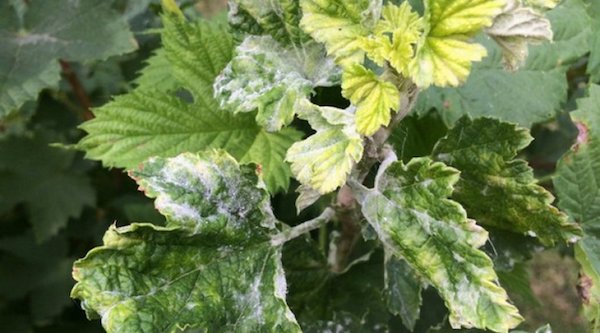

Fungal disease develops on foliage, branches, sometimes affects the fruit. Most of all, the disease affects black currant varieties. Diseased bushes tolerate frosts worse, lose their stamina and bear much less fruit.
The fungus persists in fallen leaves and hibernates well. Therefore, fallen leaves and cut branches are always burned.
Visually, the disease manifests itself as a white bloom on the leaves. There are several reasons for the appearance of powdery mildew:
- dampness and cloudy weather;
- frequent watering of the bushes;
- if infected plants grow near the currant.
If gray-brown leaves are found on the tops of the shoots, it is necessary to treat the bushes with a special solution after harvesting. In eight liters of water, 40 g of sulfur are diluted, 1 tbsp. tar soap. When processing currants, you should try to get the solution on both sides of the leaves. The twisted tops of the shoots must be cut off and burned. Processing is carried out 2-3 times.
Experienced gardeners recommend using different preparations:
- "Speed",
- "Previkur",
- Fundazol.
If the plant is thoroughly infected, then all diseased branches are cut out. It is also recommended to replace the top layer of soil around the bush. Because spores can persist in the soil and infect the treated plant again. As an additional measure, you can spray the soil around the trimmed bush with a 3% solution of "Nitrofen".
Preventive treatment
Cold, dry and calm weather is an excellent time for another stage of currant care in the fall - spraying the bushes. At the same time, protective equipment will not be washed off by precipitation, and low temperatures will prevent the development of diseases. The bushes are carefully examined before processing. Damaged branches and leaves must be removed and burned.
- Bordeaux liquid (1% solution), karbofos, copper oxychloride are used as prophylactic agents.
- Supporters of organic compounds can process the bushes with infusions of garlic, tobacco, onion peels. It should be borne in mind that herbal preparations are able to stop the reproduction of pests, but they do not completely destroy them.
Gardeners recommend planting currant plantings with garlic or onions, since the tick does not tolerate their smell.
The best option is to plant varieties that are resistant to diseases and pests: black currant Vernissage, red currant Ural beauty, and white - Pink pearl, Imperial yellow.
The most important thing is autumn pruning
Many factors affect the yield, one of them is the condition and structure of the bush. Over the course of a year, currants, especially black ones, form many dry or incorrectly positioned branches, which thicken the bush, deprive it of light and air.Growth also interferes, which takes away the strength from the plant. As a result, the yield may decrease by 2-3 times, and the bush itself will begin to ache.
If you do the autumn pruning of currants on time and correctly, you can achieve amazing results:
- reduce the number of pathogenic bacteria and fungi that live on the branches;
- increase the number of fruiting branches;
- to provide the plant with high-quality photosynthesis;
- help the currants survive the winter and resist severe frosts;
- get a bountiful harvest next year.
Much depends on the variety, but without proper care, even modern and zoned currant varieties will be stunted and will not please with yield.
Autumn pruning of currants is carried out after the leaves have fallen, not earlier.
Many gardeners, especially beginners, make the mistake of cutting off the branches before the leaves fall. Such pruning will lead to the fact that the roots of the plant will not receive the required amount of substances and will not be able to adequately respond to frost. As a result, the plant will significantly weaken after winter, and if there is a scarce snow cover in the region, it will die. Therefore, after picking the berries, only dry branches and twigs can be cut, at this moment they are clearly visible. Healthy twigs and shoots cannot be touched yet.


In red and black currants, regardless of the variety, the following types of branches are removed in autumn:
- thin, with few lateral shoots;
- diseased, broken, with signs of damage to the bark;
- very old (they are very thick and black or brown in color);
- the direction of which is inside the bush, or intersecting with other branches;
- lying on the ground, if any.
You need to work with a pruner with sharp blades, avoiding splitting branches. Hemp (twigs) should not be left, however, it is also not recommended to damage the healthy part of the branches.
Young twigs of black currant can be shortened by a third of the original length, this will provoke the development of lateral, fruiting shoots. You do not need to touch the red and white currants, you can only pinch the tops slightly - the main fruiting in these species is at the end of the branches.
Cut off parts of black currant branches can be planted in the ground, after soaking in Kornevin or another root growth stimulant. Most of the cuttings take root and grow into a full-fledged bush in a few years.
According to the rules of agricultural technology, it is believed that a black currant bush needs 6-8 main branches, young and old. In red currants, according to the rules, 10-12 branches are left. However, there are exceptions to each rule, you need to look at the state of the bush itself. The main thing is that there is no thickening - each branch should receive enough sunlight and be blown with air.
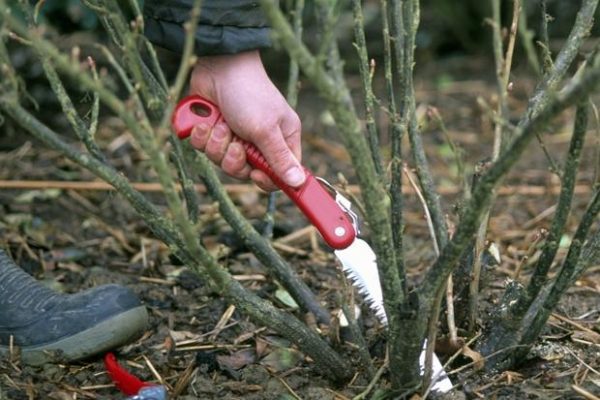

Red currants age slowly, shoots that have reached 7-9 years old are considered old. In black currant, shoots of 4-5 years are considered as such. Therefore, the crown needs to be renewed every year, gradually removing old branches and leaving younger, but stronger ones.
Preparing bushes for wintering
The currant will overwinter perfectly and will delight in the next season with a bountiful harvest, if all the measures are consistently performed. Stages of preparing currants for winter:
- old, diseased and damaged leaves are removed. The bushes are treated with agents against pests and diseases;
- the soil around the plants is cleared of fallen leaves and branches. Top dressing is introduced, the earth is dug up, watered and mulched;
- with the onset of frost, branches can be tied around the central support, but not too tightly so that the fruit buds are not damaged. When snow falls, you can collect it at the base of the bushes and compact it.
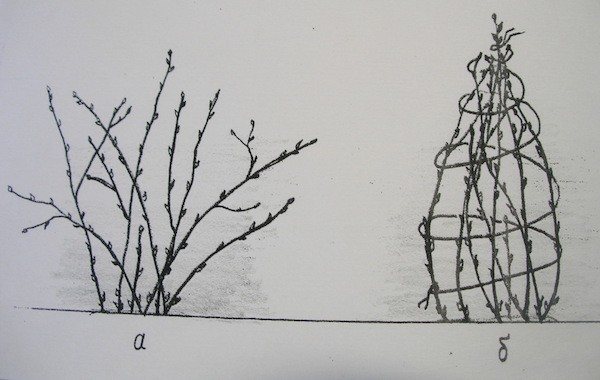

If you don't want to tie the branches, you can simply bend them to the ground and cover them with slate. It is advisable to additionally sprinkle young currants with earth.
After harvesting, do not relax, as the currant bushes begin to form buds for future seasons.If you properly take care of currants in the fall - prepare for winter, feed, protect the plants from pests, then the next season the bushes will thank the summer resident with an excellent harvest.
Warming currants for the winter
Currants, of any kind, perfectly tolerate low temperatures and are able to survive even in frosts of -20-25 ° C, and therefore few gardeners think about the need for insulation for the winter.
Meanwhile, even in the Krasnodar Territory, especially in its northern part, in winter the temperature can drop to -30 ° C and then the plant is not good enough. What can we say about the gardens of Central Russia or Siberia, where frosts and -40 ° C are not uncommon. Therefore, you need to take care of the currant warming in the fall.
This can be done in several ways:
- Gently collect all the shoots together and bend them to the ground, tying a rope with a brick to them.
- Fasten a post in the middle of the bush and tie the branches to it.
- Press the branches to the ground with a heavy board or make an arc out of the reinforcement and press it down, driving both ends into the ground.
Having done this, you can wrap the twigs in agrofiber. It is undesirable to use polyethylene - the plant will not breathe in it and may weaken or die. In such insulation, the plant can withstand frosts down to -45 ... -50 ° C.
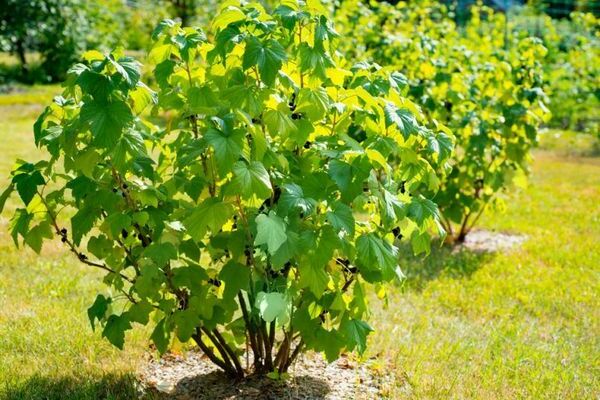

During heavy snowfall or during a thaw, you need to shake off the snow from the insulated currant, otherwise the bush will break under its weight. As soon as the danger of severe frosts has passed, the insulation must be removed.
Testimonials
Victoria, Smolensk
My whole family loves currants, so we take great care of these bushes. I use organic matter for fertilization, or rather, leaves, weeds, and mown grass. They put it all under the bushes along with the potato tops. And when all the leaves fall from the currants, I also spread the manure. As a result, there is always a good harvest of berries.
Gennady, Moscow region
Shrubs are always treated in the fall for parasites and diseases. I use ready-made complex preparations for this. Therefore, in the fall, currants are always healthy and do not suffer from pests.
Top dressing of a currant bush in autumn is an important condition for its stable development. But it is necessary to carry out the procedure strictly within the agreed time frame, observing the dosage of the selected funds. Otherwise, you can only harm the culture.
Pest control of currants
Processing currants in the fall includes pest control. How to process currant bushes? After collecting all the berries, it is necessary to spray the bush itself, the aisle, the soil with Bordeaux liquid. For beginner gardeners, it is better to purchase it ready-made and dilute it according to the instructions on the package. Bordeaux liquid is excellent for treating fungal infections. Black currants are processed at least 2 times a week.
A carbamide solution is suitable against insect larvae and fungal spores. Spraying of black currant bushes is carried out with a solution of 300 g of urea per 10 liters of water. The soil under the bushes can be watered with a light pink solution of potassium permanganate or a solution of copper sulfate. When loosening the soil, you can treat it with Karbofos or boric acid.
It is necessary to stop in time
And so until the beginning of September, alternate nitrogen with superphosphate. But in the first days of autumn, stop applying nitrogen. It acts on the metabolism, and it is time for the plant to rest. It is better for him to fall asleep earlier, otherwise being awake in the cold can lead to death.
But at the same time, you can dig in humus and compost in late autumn, when the bush has already fallen asleep. After all, this type of food decomposes for a very long time. Therefore, it will just ripen by the spring, and it will not work for the autumn and winter feeding of a sleeping bush.
An important fertilizer for currants is humus. And not only for her. This type of food is suitable for all perennials and trees. Under red and black currants, raspberries, humus is better to dig in in December.
But if you are afraid that you may not be in time before the frost, then you should drop it in several stages. Immediately in October, and later in November, December. Combine the December feedings with the thaw.
It is necessary to feed the plant according to certain rules. Wrong regimen, dosages can even harm.
The first is to add nitrogen. You will notice their influence literally in a week. Your northern grapes will be transformed, they will begin to grow actively, dormant buds will wake up, and the shoots will thicken.
After such an active urge, it is worth considering the option of adding ammonium nitrate. Such feeding of black currants will give strength to the roots. Due to their strength, they will better nourish the bush.
The introduction of potassium and phosphorus in the fall is not desirable. You can give it, but it will not lead to any result. These macronutrients affect fruit growth. But the plant, having been fed with them, quickly spends the supply. Literally a month will pass, and they will evaporate almost without a trace.
Therefore, it is worth considering how to feed any currant in the fall. Do not waste money and energy in vain.
In addition to root dressing, leaf nutrition is good for northern grapes. Once every three weeks, the treatment of the bush with urea. Reduce the dose of instructions by half. After all, you will do several sprays. After the first one, the result will be visible. Combining such leaf dressing with root nitrogen will bring good results.
How to apply fertilizers in the fall
Autumn feeding of currants must be carried out technically correctly, and using the correct ingredients. As we have already said, the first to apply nitrogen fertilizers for currants in the fall. The result can be seen within a week after fertilization. These fertilizers work very quickly, the shoots of the first year are compacted.
Manure is fertilized in mid-October. It is buried deep enough, digging up the soil to a depth of about 20 cm. Part of the manure is scattered around the currant bushes, leveled with a rake. This will perfectly saturate the soil, let the culture get all the nutrients from the ground, so that later they can be transferred to juicy and tasty berries.
What and when to feed
If currants are grown for personal use by family members, it is impractical to use a large amount of dressings. With commercial crop maintenance and high yields, it is important to select effective formulations with the right nutrient mix. Timely feeding contributes to:
- Active growth of a young plant.
- The appearance of dense and lush foliage.
- Acceleration of the ripening time of berries.
- Increase in yields.
- Improving the smell and taste of ripe berries. They are also saturated with useful vitamins and minerals.
Fertilizer for currants is used in 2 stages:
- In early spring. During this period, it is better to use nitrogen-containing compounds. 40-50 g of urea is poured under young bushes. For older plants from 4 years old use 25-40 g of mineral composition. In this case, the feeding process is divided into 2 procedures.
- In the autumn. For each bush, 4-6 kg of organic matter is used, including compost, manure, poultry droppings and other organic matter. 10-20 g of potassium sulfate and about 50 g of superphosphate are also added to the top dressing. The listed components are necessary for the full development of the culture and increase its yield.
You can also feed currants in the summer, when it spends a lot of energy on the formation and development of berries. With a deficiency of nutrients, the fruits will become bitter, crushed and dry.
Types of effective feeding
Often novice gardeners do not know how to feed black currants in the fall in order to get a decent harvest. In addition, mistakes made in feeding the bush can provoke a decrease in the plant's resistance to diseases, parasitic individuals, and death.There are many options for feeding currants, where both organic compounds and mineral complex mixtures are used. In order not to harm the berry culture, it is necessary to familiarize yourself in more detail with the features of each feeding option.
Another important point in the cultivation of berry bushes is to know how to fertilize currants in the fall. It is recommended to introduce nutrient compositions only after abundant irrigation of the soil. Otherwise, there is a high likelihood of burns on the root system of the treated plants. Watering is done at the rate of 10-20 liters of water per garden planting.
Read also: Strawberry Galya Chiv: description of the variety, reviews, photo of the bush - e
For faster delivery of useful components to the roots of the currant, a groove should be dug out, and the working solution should be poured into it. The optimum depth of such a furrow is 20-30 cm. At the end of the groove, sprinkle with soil and mulch with peat, which will avoid the formation of a hard crust on the surface.
Mineral dressing
A phosphorus-potassium mixture is an ideal option for feeding currants in the fall. Ammophos is used at the rate of 2 tbsp. per 10 liters of water, it contains 52% phosphorus and 12% nitrogen. But before use, the granules should be dissolved in a container with bitter water. Effectively add 1 tbsp to the working solution. wood ash. Under each planting add 2 liters of nutrient mixture. Only for old bushes, the dosage is increased to 5 liters.
In case of potassium deficiency, ash from deciduous trees must be added to the working solution. It is not recommended to use ash from conifers, it has a high concentration of phosphorus.
Urea, as a worthy alternative to ammophos, is also used for feeding currants in the fall. The working fluid is prepared from urea (0.5 tablespoons), potassium sulfate (1 tablespoon) and superphosphate (2 tablespoons). Before adding the nutrient composition, the granules must be stirred until they are completely dissolved. After moistening, the bushes are fed at the rate of 1-2 liters for each plant. The dosage for actively fruiting bushes is doubled. After that, the soil should be loosened and mulched.
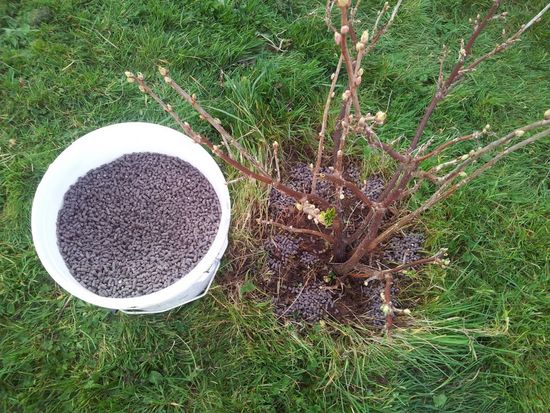

Organic fertilizers
Fertilizing currants in the fall with fertilizers can also have a combined character. So, organics are good to use together with mineral complexes. First, you need to add compost (rotted humus) under the bush, and then spill it with superphosphate (2 tablespoons of the product for 10 liters of water).
Excellent results can also be obtained when using humus, which is rationally used in 3 steps:
- The first procedure is performed in September, after having dug up the soil. Manure is spread around each planting at a distance of 1 m around the perimeter.
- The second time the feeding procedure is repeated a month later.
- The third treatment is carried out during the December thaw.
After all feeding procedures, the soil must be mulched with peat. This fertilization option for currants in the fall will allow them to be supported, stimulated to abundant fruiting for the next year.
To extend the life of the bushes and increase productivity, you need to know how to feed black currants in the fall. An excellent effect is obtained by the use of dry or diluted chicken manure in water. If dry organic matter is used, then 1 kg of chicken is introduced under the bush, which is thoroughly mixed with the ground. The soil is dug to a depth of over 15 cm. To prepare the working fluid, you will need 1 part of chicken and 15 parts of water.
After applying organic fertilizer, it is recommended to feed the currants with a mineral composition (2 tablespoons superphosphate, 1 tablespoon potassium salt, 10 liters of water). It is used at the rate of 1-2 liters of nutrient mixture per plant. The introduction of mineral complexes is allowed immediately after the application of organic matter, but it is better to do this after 1-2 days.
Kitchen waste such as potato peelings is also suitable as additional feeding. To do this, you need to dig a hole in which to lay the remains of potatoes and sprinkle with earth. It is also effective to use a nutritious infusion of dry peel (1 liter) and 10 liters of boiling water. The cleanings are steamed and then used chilled.
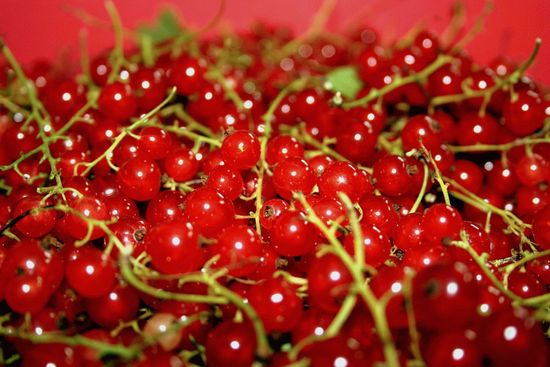

To improve the condition of the soil, it is good to sow green manure plants such as lupine, alfalfa, peas around the shrubs. Seeds are laid in early summer, and in the fall they are dug up, trying not to touch the root system of garden plantings. After that, the soil must be abundantly moistened, and then mulched.
Thanks to the use of nutritious greens, which are rich in potassium, nitrogen and phosphorus, it is possible not only to saturate the plants with useful components, but also to protect the roots.
If novice plant growers do not know how to feed currants in the fall and do not have experience in preparing nutritious mixtures, then the best option would be to use ready-made mineral complexes, which are presented in a large assortment of retail outlets. They contain potassium salt, superphosphate, urea. Due to its balance, it is not only convenient to use such a composition, but also effectively.
In addition to root dressings, it is advisable to produce nutritious sprays, since the aboveground part of the bush absorbs useful components faster than the underground one. Another advantage of foliar treatments is the additional protection of plants from harmful insects. They can be combined with standard feeding procedures. For example, after applying the organic composition under the root, spraying with a potassium-phosphorus preparation is performed.
To protect berry bushes from parasitic individuals, it is effective to use agrochemicals such as Akarin, Fitover, Fufanon. The drugs help to increase the level of resistance to various kinds of infections in the garden plantings, they can be combined with nutrient compositions.
When growing berry crops, it is required not only to adhere to the basic rules of agricultural technology, but also to know how to fertilize currants in the fall. Since the quality and quantity of the future harvest will depend on how strong the plant will come out of hibernation. Fertilizing currants in the spring will also be relevant for weakened specimens.
Meals for the spring - from autumn
We wrote above about the addition of nitrogen in the form of humus. In addition, you can use fresh cow dung or chicken dung. These natural ingredients are rich in many micro and macro elements. Therefore, do not neglect, if possible, adding them.
Manure and droppings should be applied in several stages. Make the embedding deeper the first time. And not only near the bush itself, but expand the radius to one meter. After digging, carefully mask all the moves. There should be no air flow and direct rainwater.
After a month, we fertilize again with manure or dung. But now we lay it out tightly around the perimeter and cover it with soil a little.
Remember that pure chicken droppings are very aggressive. Therefore, do not leave it near the trunk itself, but carry it a little further. By its action, it can burn leaves and branches.
Thus, the decomposed second layer of manure will remain without nitrogen after a while, but all other components will be in place. The currant will receive nitrogen from the embedding deeper.
Features of feeding red currants
In almost every household plot, you can see growing bushes of red currants, delighting the eyes of the owners with red berries. They are extremely rich in various vitamins. Although the culture is unpretentious to care for, it still needs top dressing. Lack of fertilizers and agronomic procedures can lead to lower yields.


Plant feeding table in spring.
At first, the plant will be content with fertilizing introduced in the spring when planting. But over time, the berries will become smaller and less sweet. Will lose their presentation. Young shoots are not visible in the bush. To correct the situation, the berry plant is transplanted, seasonal feeding is introduced. This will help the red currant become more resistant to disease and pests. Find out why currants turn yellow here.
Rules for the combination of organic and mineral dressings
Currants respond best to organic fertilizers, or more precisely, I slurry mullein. However, it is impossible to use only organic matter, since it contains a lot of nitrogen. Also, the mullein contains potassium, phosphorus - excess fertilizing in the fall can negatively affect the yield or reduce the resistance of the crop to negative temperatures.
It is not the feeding itself that is important, but their balance. Do not add excess amounts of nutrients.
Combined feeding is optimal for currants - in this case, organic matter alternates with chemistry. Use slurry as a top dressing requiring nitrogen. If nitrogen is contraindicated, replace the slurry with a one-component mineral composition. This article will tell you about the description and characteristics of the Malinovka apple variety.

